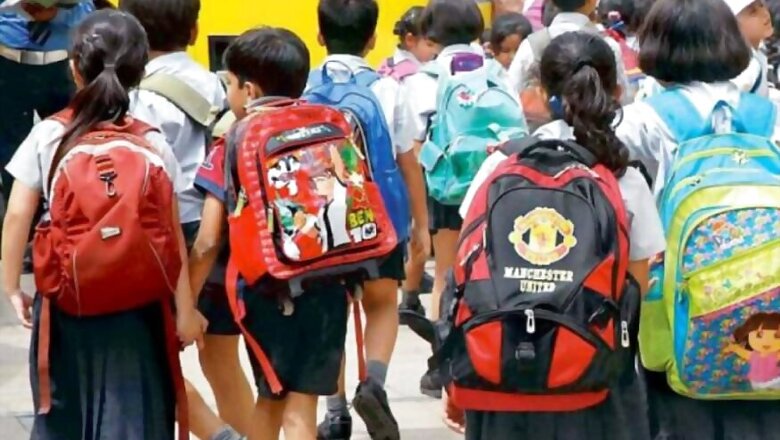
views
The draft New Education Policy 2019 includes some long-awaited shifts in the education sector like the inclusion of both early childhood education and secondary education of the Right to Education Act, doubling the budget allocation for education, strengthening decentralised mechanisms of teacher management and support, expansion of school nutrition programme to include provision of school breakfast, and a possible return of the no-detention policy.
Many of these are long-standing civil society demands and are highly welcome. However, there are some risks which must be talked about before this policy is finalised.
The policy includes some positive provisions. It reiterates the lasting position of the Indian state of prohibiting ‘for-profit’ provision in education, expects schools to adhere to standard curriculum and assessment procedures, proposes regulation of fees and makes an effort to stop commercial enterprises.
However, it also proposes loosening of mandated quality norms of schools, removes the role of government for recognition of schools (henceforth, to be done through self-accreditation, peer review and audit by school management committee members and fellow schools on regular intervals), calls for a review of the 25% reservation for poor children under Right to Education Act (RTE) as it is “unduly restrictive”, and removes all provisions of state-led inspection and enforcement of regulatory provisions.
Alarmingly, it makes a rather bizarre proposal that parents become de-facto regulators of private schools instead of the state.
This risks introducing a wild west of deregulation for private education. The principal mechanism of regulation described appears to be through uploading information in the public domain with the expectations that parents make informed choices based on the information declared and that citizens file grievances if they find misrepresentation in the claims.
There is no clarity on the role of the line department. It seems that they will have no formal direct role in verifying the validity of the claims or ensuring compliance.
There is also no evidence that access to public information alone will create a virtuous cycle that would drive up school quality through school choice and competition.
Research suggests that quality is not a significant criterion while selecting school and even when it is, parental perceptions are often idiosyncratic.
Often, parents end up choosing schools with large classes (as an indicator of high popularity and strict discipline) despite the fact that smaller class sizes are critical for improved student learning.
Furthermore, schools learn to game the system. Thus, the desire for high promotion rates has been shown to lead to lenient marking in some private schools.
The policy specifically promotes private schools, yet there is scarce evidence worldwide to suggest that private schools by definition deliver better quality, let alone, equitable education.
The World Bank’s 2018 World Development report highlights that private schools often appear to do better because they enroll children from relatively advantaged backgrounds who can afford to pay and not because they deliver better quality of education.
Recent research from India suggests that the gender gap in private enrolment is on the rise, even as it is reducing in government schools.
The policy could have instead reiterated the need for extension of the public school network to address the hitherto unreached populations in remote areas and urban slums where low fees private schools flourish.
It could have also more holistically addressed the aspirations of India’s middle class within a strengthened public education system.
Furthermore, in the absence of an operational definition of philanthropic or commercial schools (let alone a mechanism to weed out the latter) it would appear as if private schools per se are being encouraged.
In contrast, evidence exists of schools abusing their “not for profit” status, hiding profits and adopting underhand means to maximise earnings.
The spate of exclusionary incidents and the number of cases of denial of admission by private schools to poor children under the 25% quota make the proposed policy sound incredibly naïve when it says that they can be trusted and “given the autonomy to do the right thing” on their own.
An argument made in the draft policy is that legally binding quality norms under RTE are somehow detrimental to innovation and quality.
What the Act lays down is really minimal infrastructure norms like toilets for girls, ramps for children with disabilities, drinking water and a roof over students’ heads. It is unclear how the presence of these would impede learning.
There is reason to question whether innovation is even possible without these minimum prerequisites. Recognising that inputs are needed to improve outcomes, every school — government or private — should adhere to this really minimal floor of quality.
Any parent who has had children enrolled in private schools recognises the sheer power asymmetry between parents and teachers.
Poor and neo-literate parents, in particular, cannot be expected to hold the onus of ensuring that much more powerful and resourced schools comply with quality, safety and equity norms.
Data for countries relatively richer than India shows that systems with low levels of competition have higher social inclusion and that upward social mobility is higher in government systems.
Giving India’s parents access to this online information about private schools is welcome, but should not replace a formal inspection by the government to ensure adherence to school standards and a process to penalise (and eventually close) schools that consistently fail to adhere to national norms, especially in a country where many parents are illiterate and lack access to the internet.
There have to be immediate and real consequences when schools fail to adhere to what they promise to deliver.
Expecting winnowing out of non-performing schools through competition between schools to attract parents, is an inefficient and ineffective strategy. All schools should comply with the optimum standards of quality from day 1.
Regulation of private provision is an internationally recognised role of the state and the Indian government cannot afford to shrug off one of the core reasons for its existence.
Last year’s human rights council resolution explicitly reiterated that the states’ regulatory frameworks must “ensure the regulation of all education providers”, unambiguously requiring to regulate private providers.
At a time when there is a growing global consensus about the need for stronger regulation of private schools, it is unclear why India is considering a giant leap backwards from the international consensus.
Fortunately, this is still a policy draft and it can be hoped that the government would not make the mistake of going down the path of complete deregulation of private school education.
The state cannot afford to let market competition determine school quality. Our children deserve better.
(The author is a policy expert for inequality, health, education at Oxfam India. Views expressed are personal.)


















Comments
0 comment